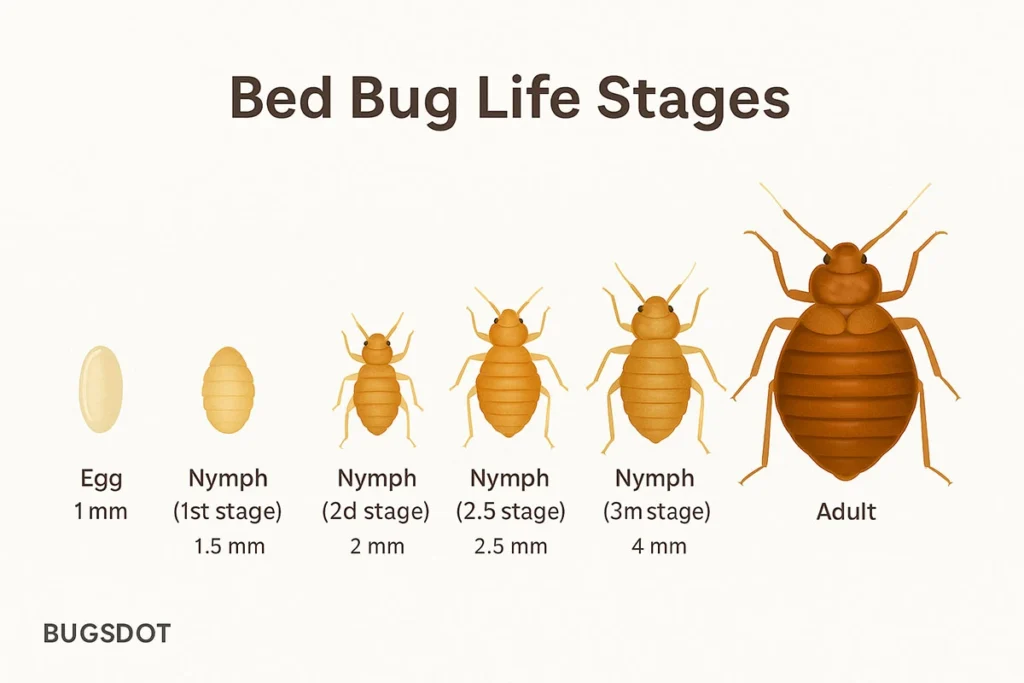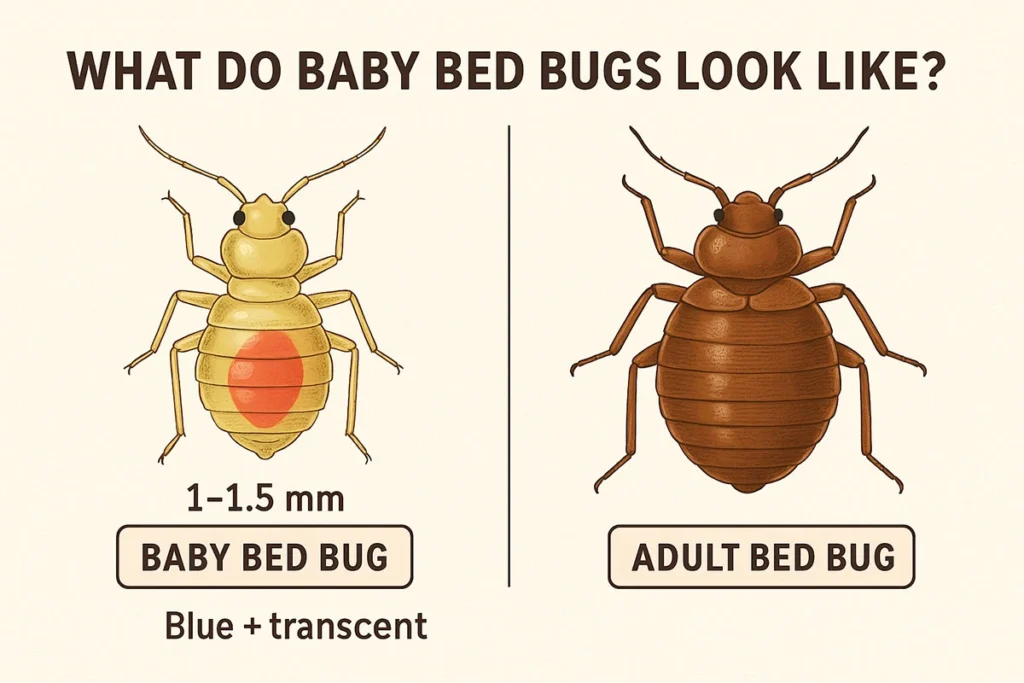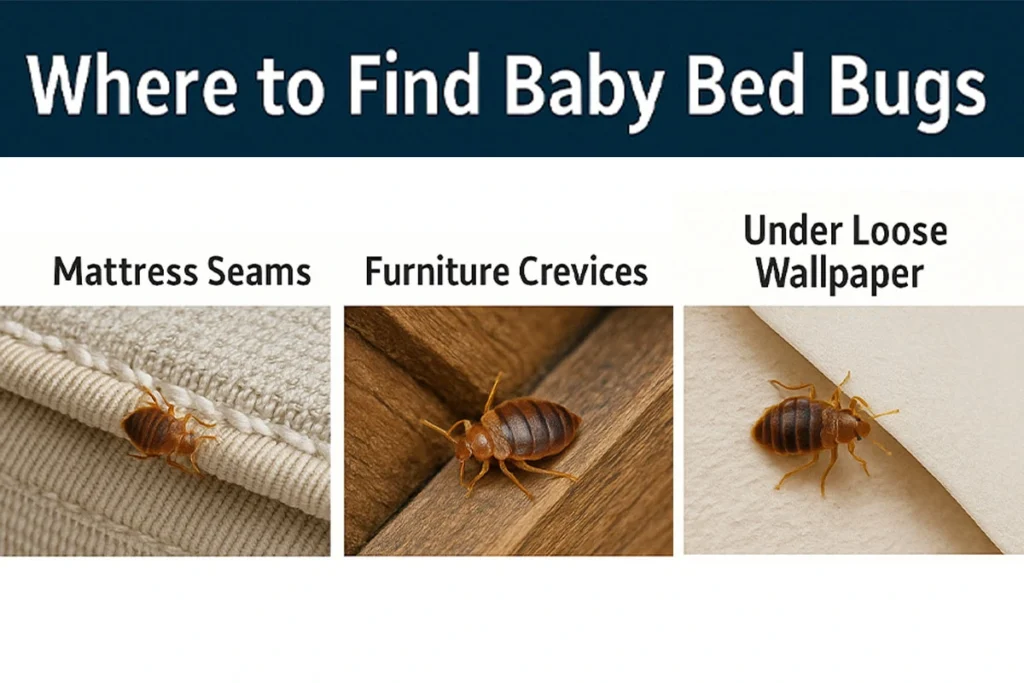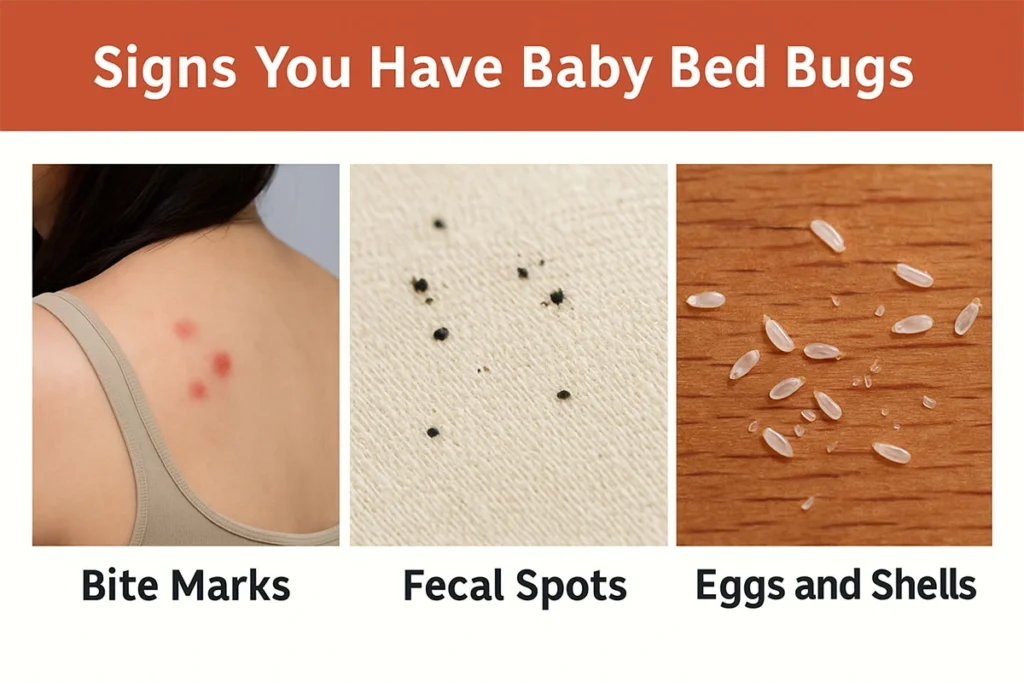If you’ve woken up with mysterious bites or spotted tiny bugs crawling on your mattress, you may be dealing with an infestation—but not necessarily adult bed bugs. You could be facing their smaller, sneakier version: baby bed bugs.
Despite their small size, baby bed bugs are just as troublesome as adults. They feed on human blood, can trigger allergic reactions, and often go undetected until the infestation becomes severe. Knowing how to recognize what baby bed bugs look like, where to find them, and how to get rid of baby bed bugs fast can save you time, money, and peace of mind.
In this guide, you’ll learn:
- What just-born baby bed bugs look like
- How to identify signs of baby bed bugs
- Why they’re hard to eliminate
- The most effective DIY and professional solutions
What Are Baby Bed Bugs?
Understanding the Bed Bug Life Cycle
To get a handle on baby bed bugs, it helps to understand the bed bug life cycle. Bed bugs (Cimex lectularius) undergo incomplete metamorphosis, meaning they don’t go through a larval stage but instead hatch into a smaller version of the adult.
Bed bug life stages:

- Egg
- Nymph (5 stages)
- Adult
After hatching, just born baby bed bugs enter the first of five nymphal stages. They must feed on blood to molt and grow into the next stage. Once they complete the fifth molt, they become adults capable of reproducing.
Each stage, including baby bed bugs, feeds on blood—and without a meal, they won’t survive or develop. However, they’re surprisingly resilient and can live several weeks without feeding, especially in cooler environments.
What Do Baby Bed Bugs Look Like?

Many people ask: “What does a baby bed bug look like?” While they resemble adults, they differ in size and color—especially when unfed.
Key Characteristics
| Trait | Baby Bed Bug (Nymph) | Adult Bed Bug |
| Size | 1–1.5 mm (newly hatched), up to 4.5 mm | 5–7 mm |
| Color | Translucent, pale yellow or light tan | Reddish-brown |
| After Feeding | Bright red abdomen (blood visible) | Dark reddish-brown |
| Shape | Oval, flat (balloon-like when fed) | Oval, flat (also balloon-like when fed) |
| Visibility | Harder to spot; hides well in crevices | More visible; often found in seams |
Baby Bed Bugs Look Like…
- Sesame seeds when fed (reddish tint)
- Clear dots when unfed
- Often mistaken for flea larvae or lice
How Small Are Baby Bed Bugs?
They are tiny—about the size of a pinhead (1 mm) when they hatch. Despite their size, they’re visible to the naked eye and move relatively slowly. Once they’ve fed, they’re easier to identify due to the red color of their blood-filled abdomen.
Where to Find Baby Bed Bugs

Because of their size, baby bed bugs hide in some of the smallest cracks and crevices.
Top Hiding Spots
- Mattress seams and tufts
- Box spring and bed frame joints
- Behind headboards and picture frames
- Cracks in baseboards or furniture
- Electrical outlets and behind wallpaper
- Inside drawers and folded clothes
Unlike adult bed bugs, baby bed bugs may be more widely dispersed because of their need to feed more frequently to grow.
Baby Bed Bugs vs. Other Small Bugs
People often confuse baby bed bugs with other household pests. Let’s clarify the difference.
Common Look-Alikes
| Bug Type | Looks Similar to Baby Bed Bug? | Key Differences |
| Flea Larvae | Somewhat | Worm-like, no legs, found on pets |
| Booklice | Yes | More translucent, prefers damp spaces |
| Spider Beetle | Sometimes | Rounder body, faster, reddish-brown |
| Carpet Beetle Larvae | No | Hairy, segmented, feeds on fabrics |
If you’re still unsure, a pest control expert or entomologist can examine a sample to provide a proper ID.
Signs You Have Baby Bed Bugs

Not everyone sees the bugs themselves. You might first notice the evidence they leave behind.
Indicators of Baby Bed Bugs
- Tiny black specks (fecal matter)
- Small red stains (crushed bugs)
- Clear or white molted skins
- Itchy, red bites in clusters or lines
- Strong, musty odor in severe cases
How to Get Rid of Baby Bed Bugs
Now that you know how to identify baby bed bugs, here’s how to get rid of them.
Step 1: Declutter and Isolate
- Remove clutter from around beds and furniture.
- Place clothes and fabrics in sealed plastic bags until treated.
- Use interceptors under bed legs to trap and monitor movement.
Step 2: Vacuum Thoroughly
- Use a crevice tool to vacuum mattress seams, baseboards, and behind furniture.
- Vacuum daily during treatment.
- Immediately empty contents into a sealed bag and discard outdoors.
Step 3: Steam Treatment
- Steam reaches 130°F or higher—enough to kill baby bed bugs and eggs.
- Use on mattresses, carpets, couch cushions, and curtains.
- Move slowly (1 inch/sec) to allow heat to penetrate deep.
Step 4: Wash and Heat-Dry Everything
- Wash clothes, bedding, and curtains in hot water (120°F+).
- Dry on high heat for at least 30 minutes.
- Place treated items in clean, sealed bins.
Step 5: Apply Diatomaceous Earth (DE)
- DE is a natural, non-toxic powder that kills by drying out the bug’s exoskeleton.
- Apply a thin layer along:
- Baseboards
- Cracks in wood or drywall
- Around bedposts and furniture legs
- Baseboards
Leave for several days, then vacuum.
Chemical Treatment Options
If DIY methods don’t cut it, consider insecticides—but only those labeled for bed bugs and safe for indoor use.
Effective Products
- Pyrethroid-based sprays (e.g., Bedlam Plus)
- Desiccant dusts (like CimeXa)
- Aerosol insect growth regulators (IGRs)
Application Tips
- Always follow the label.
- Use in well-ventilated areas.
- Target cracks, crevices, seams—not general room spraying.
For a comprehensive list of approved bed bug sprays, visit the EPA’s searchable product database.
Professional Help for Baby Bed Bugs
A serious infestation of baby bed bugs requires expert intervention.
Signs You Need a Pro
- Daily bites despite DIY efforts
- Bugs visible in multiple rooms
- Infestation has lasted over 4–6 weeks
Professional Methods
- Heat Treatment: Raises room temperature to 135–145°F for 4+ hours.
- Cryonite Treatment: Uses CO₂ ice particles to freeze bugs instantly.
- Chemical Treatment Plans: Usually requires 2–3 visits.
Most pest control companies guarantee results within 2–4 weeks using integrated pest management (IPM) techniques.
Preventing Baby Bed Bugs from Returning
Once you’re bug-free, stay that way with these prevention tips.
Ongoing Prevention Checklist
- Inspect luggage after travel.
- Avoid bringing secondhand furniture home.
- Seal cracks in walls and flooring.
- Keep bedding tucked in and off the floor.
- Check seams when staying at hotels or Airbnbs.
Use Bed Bug Interceptors
- Place under bed and couch legs.
- Check regularly for trapped insects.
- Replace every 3–6 months.
Myths About Baby Bed Bugs Debunked
Let’s clear up common misconceptions:
| Myth | Reality |
| Baby bed bugs are invisible | They’re small, but visible—especially after feeding. |
| Baby bed bugs don’t bite | They bite immediately after hatching to grow. |
| You can kill baby bed bugs with alcohol | Alcohol may kill on contact, but it evaporates quickly and isn’t a full solution. |
| Bites mean you have adult bed bugs | Bites can come from any life stage, including nymphs. |
Conclusion
Dealing with baby bed bugs early can make all the difference between a manageable problem and a costly, full-home infestation. By recognizing what baby bed bugs look like, acting quickly, and combining natural and chemical treatments when needed, you can reclaim your space.
Keep your home clutter-free, check regularly for signs, and use prevention techniques to keep these tiny invaders from coming back.




I used to be able to find good info from your articles.